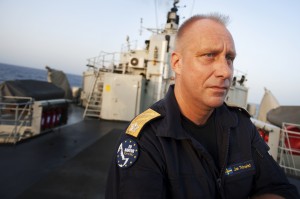Force Commander Jan Thörnqvist in mid-term: “EU NAVFOR new tactics have reduced pirate attacks”
“EU NAVFOR’s new tactic has been successful, we are disrupting more suspected pirates near the coast, before they put on the high seas and conduct hijackings. The challenge is that once they get through they venture further and further out on the Indian Ocean,” said Rear Admiral (LH) Jan Thörnqvist when he sums up his first two-month as Force Commander.
 |
| FORCE COMMANDER JAN THÖRNQVIST Source: EU NAVFOR Click to enlarge |
The Swedish lead of EU NAVFOR – operating in the Indian Ocean, the Gulf of Aden and the southern Red Sea – is now half way through the time of its rotation. In mid-April, Admiral Jan Thörnqvist took command over the EU fleet off Somalia and became the first Swedish Force Commander to lead an EU-mission. Everything is not “hunting pirates” even if that gets more headlines. So far under Swedish leadership The EU Task Force has conducted eight escorts for the UN agency World Food Programme (WFP) and 13 escorts of the African Union’s peacekeeping operation in Somalia (AMISOM).
“It is important that we solve our main tasks, to escort WFP ships with humanitarian aid to Somalia’s 1.6 million internally displaced persons and to escort the AMISOM transports”, notes Force Commander Jan Thörnqvist.
The Swedish admiral and his multinational Force Headquarters, FHQ, have seen both successes and tough challenges. The fact that the new more proactive EU NAVFOR-tactics are successful is proven by statistics; In the first two months, the force managed to disrupt or prevent piracy at about 15 times and a dozen pirate ships, with equipment and weapons, were destroyed or seized by the EU NAVFOR.
A tough challenge in the first period of 2010 has been that the pirates are further out in the Indian Ocean, sometimes closer to India than Somalia. One example is the hijacking April 18, as far as 1200 nautical mil east of the coast of Somalia. Compared to the same period a year ago, data suggest two things: the total number of pirate attacks have increased by 150 percent, but the number of completed hijackings dropped by 25 percent.
“Pirates recruit more young men who are sent further out on the high seas. Their plan is apparently to make a large number of attacks over a larger area, but we are often able to disrupt them before they complete a hijack,” says Admiral Thörnqvist.
Now in June and July, the monsoon is increasing and it becomes more difficult for pirates to operate east of Somalia, in the Indian Ocean and for some time the focus moves north, to the more sheltered Gulf of Aden.
“From a Swedish perspective, we note that HSwMS Carlskrona has worked very well as Flag ship and the new Swedish helicopter, Agusta 109 LUH, has shown a higher availability than we counted on in this tough climate. We also realised that having a helicopter on board is a requirement for the full use of the unit in this type of operation”, explains Force Commander Jan Thörnqvist.
Press release
EU NAVFOR

 von
von